List of Authors
>>About this blog
Recent blog post
|
[Sam]
Nov. 30, 2015 14:00
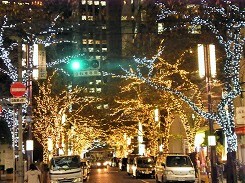 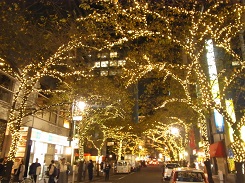
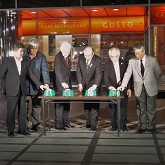 Nihonbashi Sakura-dori St. is bustling with "Sakura Festival" in spring and "TOKYO ILLUMILIA" in winter. Nihonbashi Sakura-dori St. is bustling with "Sakura Festival" in spring and "TOKYO ILLUMILIA" in winter.
On November 27, the annual year-end illumination "TOKYO ILLUMILIA 2015-2016" lights up.
Date: From November 27 to February 14, 2016 16:30 to 23:00
Theme: "Gate of Light" that connects the past, present, and future
The Sakura-dori St., which leads from the Yaesu Exit of Tokyo Station to Nihonbashi, is regarded as the gate, creating a "gate of light" <Yaesu / Nihonbashi> that connects the past, present, and future.
The cherry tree facing the intersection of Sakura-dori St. is decorated with white LEDs to the tip of the branch, so that the branches that have grown greatly overlap and represent the "gate of light".
The cherry trees between the intersections use golden LEDs, and graceful lights are connected to the "gate of light".
A total of about 160,000 LED bulbs are displayed on about 70 300m rows of cherry trees.
From 18:00 on the 27th, at Nihonbashi Plaza Hiroshi Minamiba, the organizers "Nihonbashi Yaesu Nakadori Shopping Association", "Nihonbashi 2-chome Tooricho Association Shopping Association", "Nihonbashi 3-chome Nishimachi Association / Shopping Association", "Yaesu 1-chome Store Association" and "Yaesu 1-chome Central Shopping Association", Mr. Yata Chuo Ward Mayor's.
[Sam]
Nov. 25, 2015 12:00
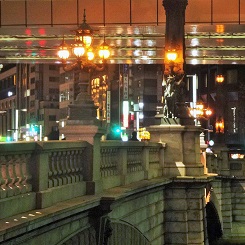 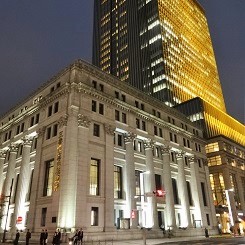
On November 20, "NIHONBASHI ILLUMINATIONS collaboration with FLOWERS" (Nihonbashi Illumination), where you can enjoy early cherry-blossom viewing, will begin for the first time in the Nihonbashi area.
The theme is "Spring".
In various parts of the Nihonbashi area, illuminations with the motif of spring flowers are lit and bloomed gradually. The plan is to gradually roll out in the city, and in the New Year it will be gorgeously in full bloom, and to wrap the winter Nihonbashi in winter with spring light.
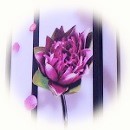 Box-shaped illuminations will appear at the four facilities of Choledo Muromachi 1, Choledo Muromachi 2, Choledo Muromachi 3, and Choledo Nihonbashi from November 20 to February 11 (planned). At the time of lighting, the patterns of flowers waiting for flowering are reflected behind shoji door, and colorful flowers are in full bloom before Christmas. Box-shaped illuminations will appear at the four facilities of Choledo Muromachi 1, Choledo Muromachi 2, Choledo Muromachi 3, and Choledo Nihonbashi from November 20 to February 11 (planned). At the time of lighting, the patterns of flowers waiting for flowering are reflected behind shoji door, and colorful flowers are in full bloom before Christmas.
During the period from December 11 to February 11, the exterior walls of the Mitsui Main Building will be dyed with fantastic illuminations inspired by spring flowers.
The light color of the illumination based on the cherry color is linked to the movement of the wind and the light-up pattern changes, and the illumination gradually increases color and glossiness with the passage of time, and the wall is in full bloom in spring light in the New Year It seems to be
On Muromachi Nakadori, between COREDO Muromachi 1 and COREDO Muromachi 2, "Ohanami Japanese lantern," where 100 Japanese lanterns are dyed in flower patterns during the Christmas season from December 11 to February 11, has an "interactive lighting show".
From January 8 to February 11, 2016, "FLOWERS BY NAKED" is scheduled to be held at Nihonbashi Mitsui Hall.
In the core work, a collaboration work with Ikebana Sogetsu-ryu family former Akane Teshigahara was set up, and a new "flower" that sublimates the "fragile beauty" and "life force" of real flowers with advanced digital art. I hear that this event expresses how to enjoy "flowers".
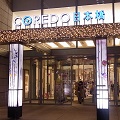 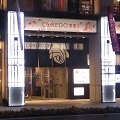 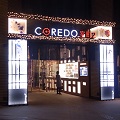 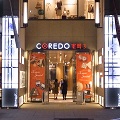
[Sam]
Nov. 24, 2015 12:00
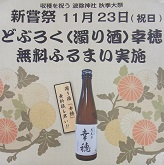 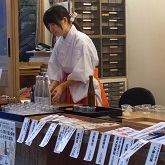 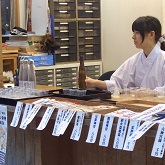
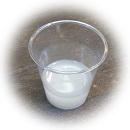 On November 23, the autumn festival "Niiname-no-Matsuri" was held at Tsukiji Namiwa Inari Shrine, one of the three festivals a year. On November 23, the autumn festival "Niiname-no-Matsuri" was held at Tsukiji Namiwa Inari Shrine, one of the three festivals a year.
Niiname-no-Matsuri is a festival to appreciate the autumn harvest that has been held at shrines nationwide, including the Imperial Palace since ancient times.
In front of the rice sculptor Chita Seiun, which was burned down in the late Edo period, was revived by a wood sculptor Chita Seiun, a Kaga lion head in Tsurugi-cho, Ishikawa-gun, Ishikawa-Nigori sake (now Yawata-cho, Hakusan-shi).
On the day, worshipers will be served with precious Nigori sake "Koho" whose production is limited. (It will end as soon as it runs out)
In addition, those who attend the first course (3,000 yen per bite) will be awarded "Koho" (limited to 250 bottles) and Hatsuho, Shinmai Nigo, and amulet from the sacred rice field.
In addition, the sake "Namisai" made from rice from the sacred rice field will be offered to the festival in June of the following year.
All are brewed at the "Manzai Raku" brewery Kobori Sake Brewery in Tsurugi Honmachi, Hakusan City (former Tsurugi-cho, Ishikawa-gun).
[Sam]
Nov. 21, 2015 09:00
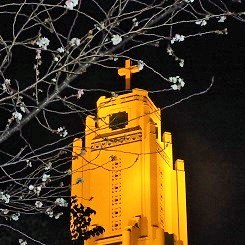 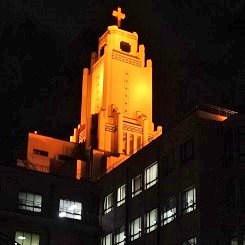
 "St. Luke's International University (formerly St. Luke's International Hospital) St. Luke's Chapel" was established in 1902 as a chapel of St. Luke's Hospital, founded in 1902 by Toysler, a missionary doctor of the U.S. "St. Luke's International University (formerly St. Luke's International Hospital) St. Luke's Chapel" was established in 1902 as a chapel of St. Luke's Hospital, founded in 1902 by Toysler, a missionary doctor of the U.S.
The current chapel is a Neo Gothic style built in 1936 after the Great Kanto Earthquake of 1923 and a fire two years later. (Decorating is an art deco style)
At that time, you can see the cross on the roof of the hospital from any hospital room, and it is said that it was a mental support for the patient.
Currently, there are two "places of prayer": "Chapel (chapel)" on the 2nd floor of the old building of the hospital and "Toysler Memorial Hall (completed in 1992 <Korea Hall>) on the 2nd floor of the new building.
As a place to find the ability to respond to various problems, including illness, while calming and praying, we continue to play a role as a place for revelation of the mental pillars of medical care and education held at St. Luke International Hospital / International University.
The two "places of prayer" are connected by the corridor.
In the recent redevelopment project for the entire hospital premises (St. Luke Life Science Center Initiative), the central part including the chapel of the old hospital building has been preserved and restored.
("Chapel and attached old ward" is selected by Tokyo Metropolitan Historic buildings)
From the tower of the old building, the melody of the choir flows every day at 8:30, 12:00 and 18:00.
In the evening, the spiral with a cross is lit up in orange, and clearly emerges in the night sky.
"October cherry blossoms" are planted in the courtyard.
It is said to be the subspecies of Kohigan, a hybrid of Edhigan and Mamezakura, and blooms intermittently small double-flowered flowers from October to early spring.
The flower color is white to pale pink, with 3 to 5 flowers blooming sparsely.
There is no gorgeousness, but with the illuminated chapel in the background, it creates a dignified atmosphere unique to this season.
There is a refreshing and harsh air.
[Sam]
Nov. 18, 2015 16:00
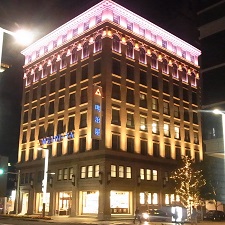 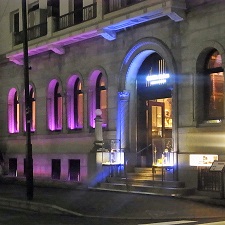
The renovation of the Meijiya Kyobashi Building has been completed following the redevelopment of the Kyobashi 2-chome west area.
Following the opening of the office floor on August 31, the Meijiya Kyobashi store was newly opened on September 16.
Completed in 1933 (designed by Sone Nakajo Architects) renovated after preserving the elegant appearance of the Italian Renaissance style at the time.
In addition to the classic plant decoration called Acanthus, the beautiful details decoration is alive.
At night, it is equipped with a colorful light-up function with LED lighting, and it is a new outfit.
The completion of the entire redevelopment of the Kyobashi 2-chome West Area is scheduled for fall 2016.
On the other hand, the Yonai Building (Ginza 2) was completed in 1930. (Design: Matsunosuke Moriyama)
It is a Romanesque-style design in the Middle Ages, and the arch windows with spiral pillars are impressive.
It gives a light accent to the solid stone wall. (Historic buildings, Tokyo)
On the 1F and B1F, in April 2015, the Henri Charpantier Ginza store, which was inspired by Osman-style Partman in Paris, was renovated and reopened as "Ginza Maison Henri Charpantier".
The concept is "Wonderland of dreams separated from everyday life."
In addition to the "Boutique" at the back of the 1st floor and the "Salon de Te" on the B1st floor, there is also a "barmaison" where you can enjoy desale with alcohol.
The glittering illuminations of the brand shop on the main street are also splendid, but the new outfit of the retro building is also delicious and worth seeing.
[Sam]
Nov. 17, 2015 16:00
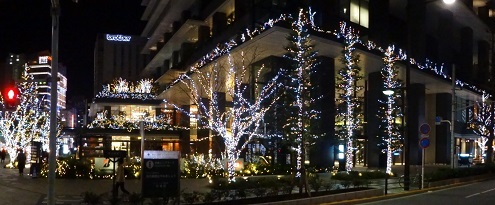
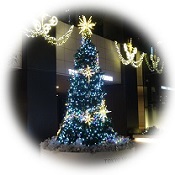 Tokyo Square Garden is now in its third year of opening this year. Tokyo Square Garden is now in its third year of opening this year.
From November 6th, the annual "Winter Illumination 2015-Starlight Happiness-" started.
Date: From November 6 to February 29, 2016 16:00 to 24:00
The 170,000 white & champagne-color LED bulbs set up in the B1F station square, road street trees, and the low-rise superimposed greening space "Kyobashi no Oka" emit three-dimensionally high-quality sparkle.
A Christmas tree with gorgeous decorations appears in the B1F station square.
It can also be used as a photo spot.
(Christmas tree until December 25)
Illumination that is deployed throughout the square site that integrates the two blocks through block reorganization.
You can enjoy the illuminations with one of the best scales in the neighborhood.
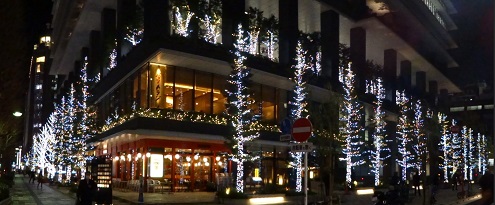
|
Links
|


 Nihonbashi Sakura-dori St. is bustling with "Sakura Festival" in spring and "TOKYO ILLUMILIA" in winter.
Nihonbashi Sakura-dori St. is bustling with "Sakura Festival" in spring and "TOKYO ILLUMILIA" in winter.

 Box-shaped illuminations will appear at the four facilities of Choledo Muromachi 1, Choledo Muromachi 2, Choledo Muromachi 3, and Choledo Nihonbashi from November 20 to February 11 (planned). At the time of lighting, the patterns of flowers waiting for flowering are reflected behind shoji door, and colorful flowers are in full bloom before Christmas.
Box-shaped illuminations will appear at the four facilities of Choledo Muromachi 1, Choledo Muromachi 2, Choledo Muromachi 3, and Choledo Nihonbashi from November 20 to February 11 (planned). At the time of lighting, the patterns of flowers waiting for flowering are reflected behind shoji door, and colorful flowers are in full bloom before Christmas.






 On November 23, the autumn festival "Niiname-no-Matsuri" was held at Tsukiji Namiwa Inari Shrine, one of the three festivals a year.
On November 23, the autumn festival "Niiname-no-Matsuri" was held at Tsukiji Namiwa Inari Shrine, one of the three festivals a year.

 "St. Luke's International University (formerly St. Luke's International Hospital) St. Luke's Chapel" was established in 1902 as a chapel of St. Luke's Hospital, founded in 1902 by Toysler, a missionary doctor of the U.S.
"St. Luke's International University (formerly St. Luke's International Hospital) St. Luke's Chapel" was established in 1902 as a chapel of St. Luke's Hospital, founded in 1902 by Toysler, a missionary doctor of the U.S.


 Tokyo Square Garden is now in its third year of opening this year.
Tokyo Square Garden is now in its third year of opening this year.

